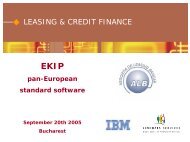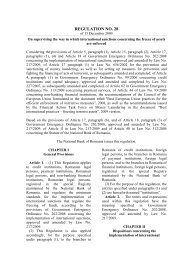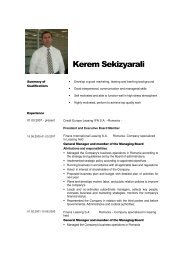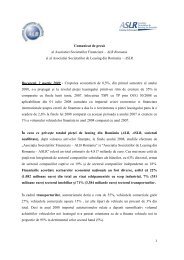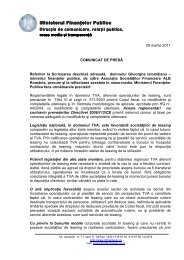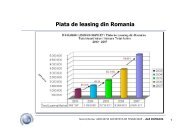Descarca catalogul - ALB
Descarca catalogul - ALB
Descarca catalogul - ALB
You also want an ePaper? Increase the reach of your titles
YUMPU automatically turns print PDFs into web optimized ePapers that Google loves.
consum, in special cele in devize (doritorii sunt<br />
obligati sa prevada garantii acoperitoare de cel<br />
putin 133 la suta din finantarea totala; durata<br />
creditului nu trebuie sa depaseeasca cinci ani;<br />
au fost introduse constrangeri suplimentare<br />
pentru debitorii expusi riscului valutar etc.) fara<br />
a impiedica insa accesul la creditele ipotecare<br />
imobiliare. Aceasta Reglementare include<br />
cerinta explicita pentru creditor de a-si informa<br />
si avertiza clientii asupra riscurilor asociate cu<br />
imprumuturile in devize”. In 2012 organismul<br />
de reglementare si-a exprimat in mod clar<br />
intentia de a extinde aceasta Reglementare la<br />
entitatile juridice cu privire la constientizarea<br />
si asumarea riscurilor pe care debitorul nu<br />
le poate intelege ori gestiona. Din punct de<br />
vedere al reglementarii, anul 2011 a fost marcat<br />
de adoptarea Standardelor Internationale de<br />
Raportare Financiara (IFRS) care implica<br />
schimbari ale cadrului de reglementare sub<br />
aspectul capitalizarii, provizionarii, nivelelor de<br />
lichiditate ale institutiilor de credit fara a include<br />
IFN-urile sub umbrela acestei noi reglementari!<br />
Aceste cerinte prudentiale noi legate de IFRS,<br />
care au scopul de a acoperi riscurile in mod<br />
adecvat, sunt extrem de asteptate pentru a fi<br />
implementate si in piata IFN-urilor.<br />
granting consumer loans, especially foreign<br />
currency-denominated lending (applicants are<br />
bound to provide collateral covering at least<br />
133%of the total financing; loan term shall not<br />
exceed five years; supplementary constraints<br />
for unhedged borrowers were introduced<br />
etc.) without hampering access to real estate<br />
mortgage loans. The Regulation includes the<br />
explicit requirement for the creditor to inform<br />
and warn its clients about the risks associated<br />
with foreign currency-denominated lending.”<br />
In 2012 the regulator has expressed its intention<br />
to extend this Regulation to legal entities with<br />
respect to awareness and assumption of risks<br />
that the debtor cannot understand or manage.<br />
Year 2011 was marked from the regulatory point<br />
of view by the adopting of the International<br />
Financial Reporting Standards (IFRS) that<br />
meant changes to the regulatory framework<br />
in terms of capitalization, provisioning,<br />
liquidity levels of credit institutions without<br />
including the NBFIs under the umbrella of<br />
this new regulation! This new IFRS prudential<br />
requirements that are aimed to cover risks in<br />
an adequate manner are highly expected by the<br />
NBFI market to be implemented, too.<br />
In „Raportul anual al Bancii Nationale a<br />
Romaniei din 2011” cu privire la realitatea<br />
economica se arata ca „cele mai afectate<br />
au fost IMM-urile, deoarece rata de credite<br />
neperformante a acestora a avut cea mai rapida<br />
crestere si cel mai inalt nivel (20,9 la suta la<br />
sfarsitul lunii martie 2012). A crescut si riscul<br />
de credit cu privire la imprumuturile legate<br />
de bunurile de uz casnic, insa cu un ritm mai<br />
mic (de 9,0 la suta la sfarsitul lunii martie<br />
2012 de la 7,9 la suta la sfarsitul anului 2010),<br />
vulnerabilitatile cele mai mari ramanand cele<br />
de mare indatorare si cele privind devizele<br />
considerabile pe termen scurt.<br />
Rata creditelor neperformante din sectorul<br />
marilor clienti a ramas la 3,7 la suta la sfarsitul<br />
lunii martie 2012, cele mai importante riscuri<br />
According to the “2011 Annual Report” of the<br />
National Bank of Romania with respect to the<br />
economic reality “the hardest hit were smalland<br />
medium-sized enterprises, as their nonperforming<br />
loan ratio posted the fastest growth<br />
and the highest level (20.9%at end-March<br />
2012). Credit risk attached to household loans<br />
also expanded, albeit at a slower pace (to 9.0%<br />
at end-March 2012 from 7.9%at end-2010),<br />
with high indebtedness and the substantial short<br />
foreign currency position remaining the major<br />
vulnerabilities.<br />
The corporate sector’s non-performing loan<br />
ratio stood at 3.7% at end-March 2012, with the<br />
most significant risks coming from a relatively<br />
low debt servicing capacity and loose payment<br />
discipline among business partners. “<br />
21<br />
60184_file_interior_lucian_v9.indd 21<br />
11/5/2012 9:21:52 AM



